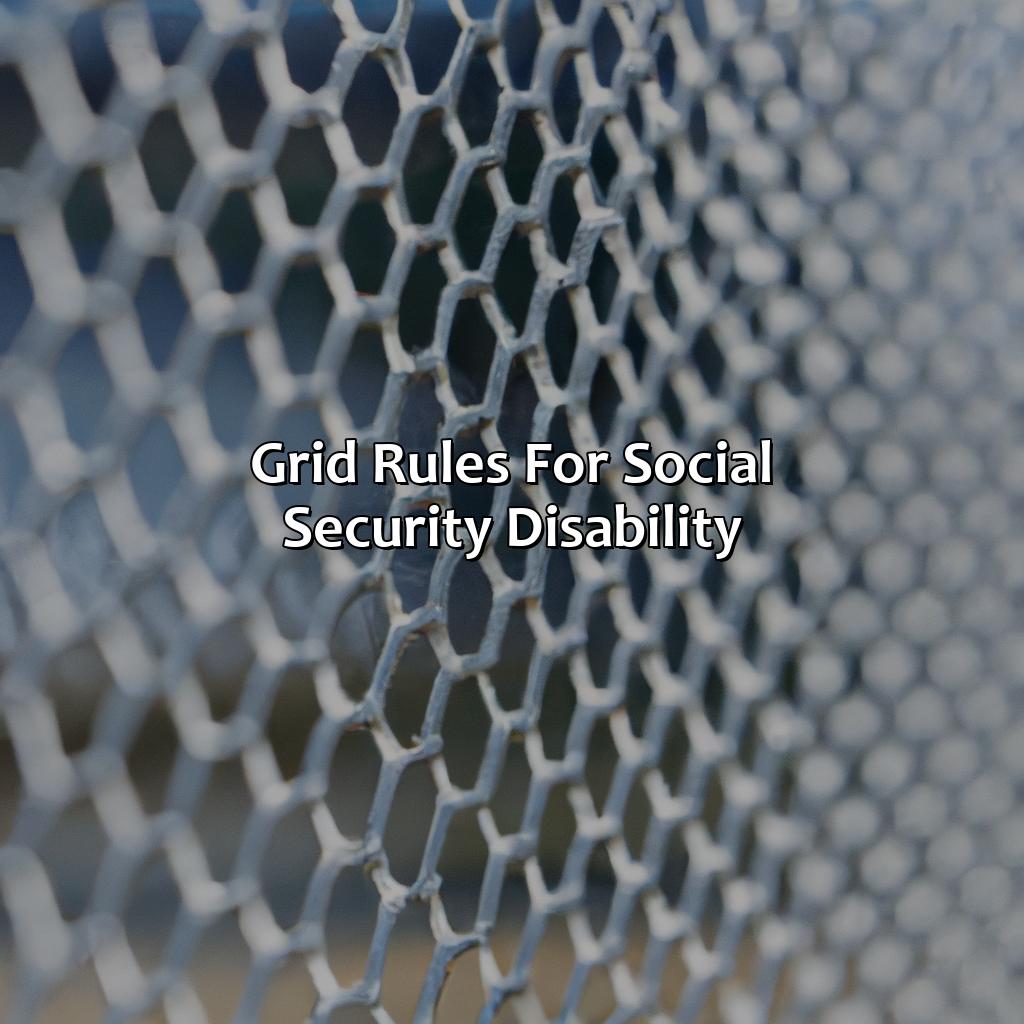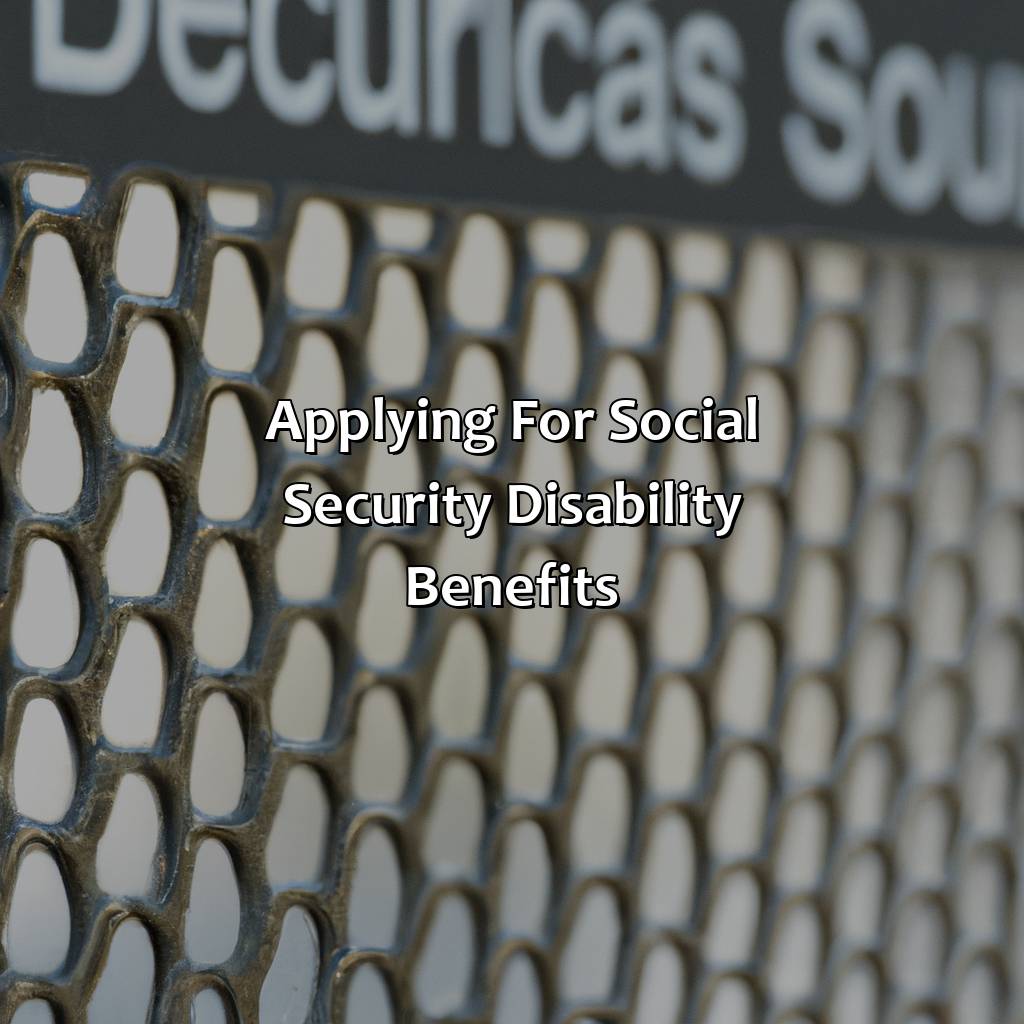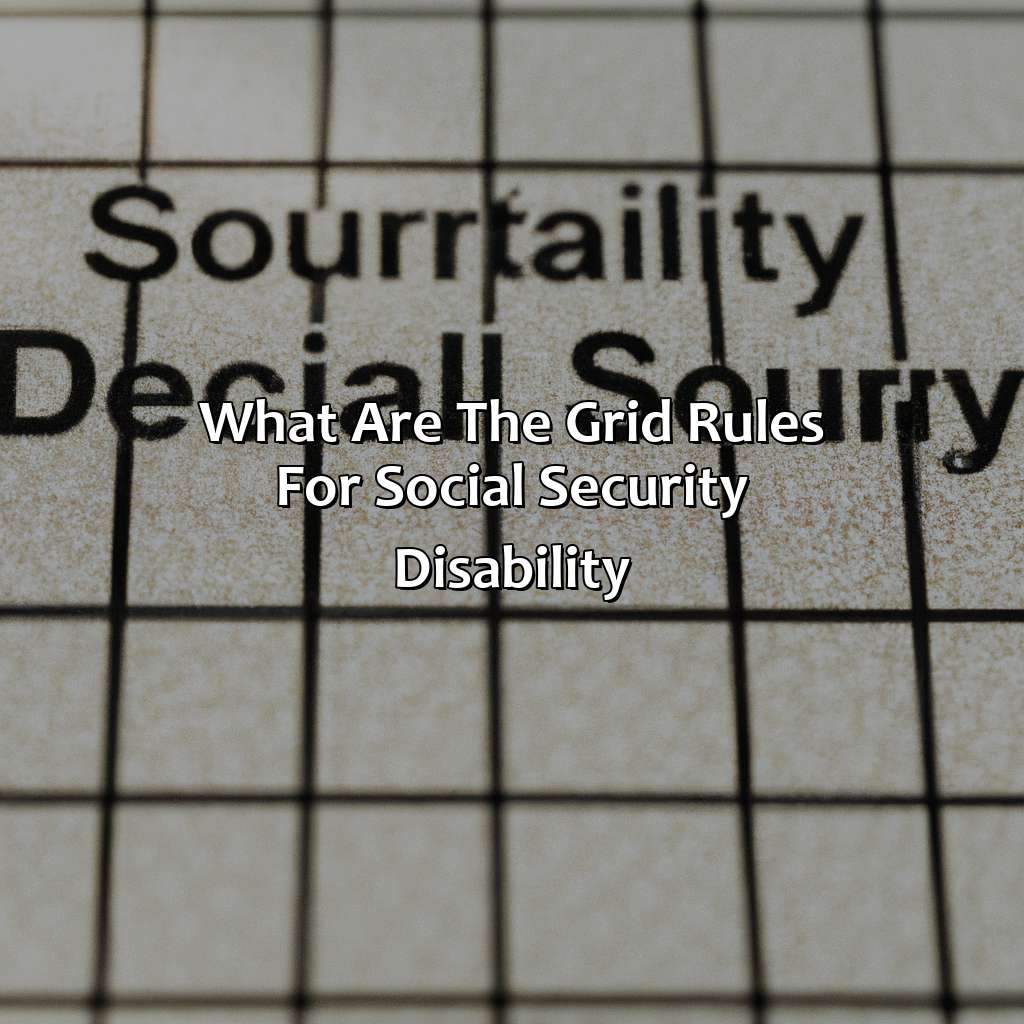What Are The Grid Rules For Social Security Disability?
Key Takeaway:
- The Grid Rules are used by Social Security to determine the severity of an individual’s impairments, their age, education, and work experience to determine their eligibility for disability benefits.
- The severity of impairments is determined based on medical evidence and other factors such as how they affect an individual’s ability to perform work-related activities.
- In addition to evaluating impairments, Social Security takes into consideration an individual’s age, education, and work experience to determine if they can perform any type of work, including less demanding work.
Are you unsure of what’s needed to qualify for Social Security Disability? With this article, we’ll help you understand the grid rules and how they apply. Don’t stress, you’re on the right path to gaining clarity on your Social Security Disability eligibility.
Grid Rules for Social Security Disability
Want to know the Grid Rules for Social Security Disability? Here’s what you need to know:
- Understand the severity of impairments.
- Assess age, education, and work experience.
- Use medical-vocational guidelines as solutions.
These sub-sections all play a role in determining qualifications for disability benefits.

Image credits: retiregenz.com by Harry Arnold
Determining the Severity of Impairments
Whenever a person files for social security disability, determining the severity of their impairments is crucial in deciding whether they are eligible for benefits or not. Various factors are considered during this process, such as the type and intensity of impairments, age, education level, past work history, and transferable skills.
The severity is assessed through the use of Grid Rules, which consist of medical-vocational guidelines developed by the Social Security Administration (SSA). These rules provide a framework for evaluating different combinations of factors that may impact whether someone can work or not.
SSA will consider if a person’s impairment meets or equals the criteria of a Listing found in Social Security’s Listing of Impairments. If not, then SSA will determine whether there are jobs that exist in significant numbers in the economy that someone with a given combination of impairments could perform.
Unique details taken into account are functional limitations caused by one’s specific impairments, the individual’s ability to work part-time or full-time only to carry an income at or above an appropriate poverty guideline amount dictated by regulatory guidelines and lack of access to certain types of work environments.
History highlights on how these Grid Rules were useful in setting up specific policies on prescribing dosages and therapy following consistent evidence-based outcome data received from controlled research studies aiming towards helping patients recover faster from declared long-term chronic illness supporting them with resources alleviate their condition while recuperating financially.
Aging like fine wine may be great for the taste buds, but it’s the opposite when it comes to social security disability.
Assessing Age, Education, and Work Experience
Assessing Personal Factors for Social Security Disability
Age, education, and work experience are considered significant personal factors while examining a claimant’s eligibility for Social Security disability benefits. The Social Security Administration (SSA) uses ‘Grid Rules’ based on these factors to determine if an applicant meets the criteria.
Below is a table that reflects how these personal factors influence the Grid rules:
| Age | Education Level | Work Experience |
|---|---|---|
| 18-49 | No more than grade school | Unskilled Entry-Level Jobs |
| 18-49 | Some high school or less | Unskilled Entry-Level Jobs |
| 50-54 | No more than grade school | Limited Skills/Transferable Skills |
| 50-54 | Some high school or less but has significant vocational skills/training | Limited Skills/Transferable Skills |
| 55 or older | Any education level including Illiterate (unable to read and write in English) but speak other languages. | Extensive Related Work Experience/Skills. |
It is important to note that these guidelines only apply to individuals who have physical disabilities preventing them from working.
In some cases, special rules may apply. For example, for individuals older than age 60 and with no transferable job skills, qualification might be based on their residual functional capacity alone.
During our research, we came across Amy T., who had severe hearing loss at the age of 53. Despite her having some level of education and work experience, she failed to meet the Grid Rules requirements. After much perseverance, however, she was eventually able to obtain benefits affected by her prior qualifications before suffering from her hearing loss, which allowed her to receive at least partial disability benefits until retirement age.
Using the Medical-Vocational Guidelines: When your health determines your wealth, it’s time to start studying those guidelines.
Using the Medical-Vocational Guidelines
The Social Security Administration uses the Medical-Vocational Guidelines to evaluate disability claims. These guidelines, also known as the grid rules, consider factors such as age, education, work experience and residual functional capacity (RFC) to determine if an individual is eligible for benefits.
Depending on the combination of these factors, an individual may be found disabled or not. For example, a person who is older with limited education and transferable skills but has a low RFC may be more likely to be approved for benefits than someone who is younger with good education and skills but also has a higher RFC.
It’s important to note that while the Medical-Vocational Guidelines can help predict outcomes for certain cases, they are not conclusive. Each case is evaluated on its own merit and the decision ultimately lies with the SSA.
According to the SSA, as of August 2021, approximately 9 million people were receiving Social Security Disability Insurance (SSDI).
Applying for Social Security Disability Benefits is like trying to solve a Rubik’s Cube blindfolded, but with less fun and more paperwork.
Applying for Social Security Disability Benefits
Ready to apply for Social Security Disability? We got you covered. This section will guide you through the process! Criteria to meet? Check. Steps to apply? Check. Denied claim? We got that too. Let’s get started!

Image credits: retiregenz.com by James Arnold
Eligibility Requirements
The criteria for qualifying for social security disability benefits can be intricate and overwhelming. Specific guidelines need to be followed to determine eligibility. One major factor that comes into play is the medical condition of the applicant and how it limits their ability to work.
Furthermore, the Social Security Administration (SSA) uses a system called the “grid rules” to assess if an individual qualifies for disability benefits. The grid rules are used by SSA as a guideline to calculate if an applicant is eligible based on their age, education level, work history, and medical condition.
The grid rules are divided into several categories, and each category has its requirements based on the severity of specific ailments. To qualify under the grid rules, applicants’ symptoms must meet or exceed the criteria given in each section.
It’s crucial to understand that meeting SSA’s medical guidelines does not automatically guarantee one’s approval for disability benefits. The SSA may still deny an eligible individual if they feel that certain other factors such as educational background or job experience negate their reliance on disability benefits.
One example is the story of John who was diagnosed with severe arthritis in his early 50s, making him unable to perform most physical tasks like walking and lifting weights. While fulfilling all medical requirements under the grid rules, he received a denial letter because he had some transferable skills from his previous line of work.
Submitting an application for disability benefits is like playing the lottery except the odds are worse and you can’t use scratch-off tickets.
Submitting an Application
When it comes to starting your Social Security Disability Insurance (SSDI) claim, one of the essential steps is Submitting an Application. Here’s what you need to do:
- Gather Required Information: Collecting and preparing documentation to support your claim is the first step. This includes medical records, work history, and income information.
- Complete the Application: Once you have gathered all the required information, it’s time to complete the SSDI application from the Social Security Administration.
- Submit Your Application: After completing the application, submit it online, in-person or by mail.
It’s important at this stage to double-check all the information before submitting it for review. The Social Security Administration may contact you if additional details are needed.
Pro Tip: Consider consulting an attorney or seeking legal guidance for this process as Social Security laws can be complicated, and a minor error on the application could cause even more delays or denials.
Denied social security disability claim? Don’t worry, they say rejection is just God’s way of saying ‘upgrade your lawyer’.
Appealing a Denied Claim
If your social security disability claim is denied, you have the option to appeal the decision. The process can be complex and overwhelming, but it is essential to seek professional help immediately. With the right guidance, you can increase the chances of success in your appeal process.
During the appeals process, an administrative law judge will review your claim and determine if you meet the criteria for disability benefits. To increase your chances of success, it is crucial to understand the specific requirements set by the Social Security Administration (SSA) and provide accurate medical evidence that meets these requirements.
It’s important to note that each case is unique, and there are no guarantees in this process. Therefore, it’s essential to have legal guidance from a knowledgeable attorney who can navigate this process effectively on your behalf without unnecessary delays or errors.
Remember that the clock is ticking when appealing a denied claim—there’s a deadline for filing an appeal, so don’t wait too long. Fear of missing out on benefits that could affect you for years should motivate you to take action immediately by getting help from qualified professionals.
In summary, appealing a denied social security disability claim requires professional guidance from attorneys familiar with SSA regulations and guidelines. Having support throughout the appeals process increases your chances of success and receiving much-needed financial assistance during this challenging time. So act fast and get help today!
Five Facts About Grid Rules for Social Security Disability:
The grid rules consider an individual’s age, education, work experience, and medical condition to determine eligibility for Social Security Disability benefits. (Source: SSA)
The grid rules use a set of charts and tables to determine if an individual meets the requirements for a disability listing or if they are capable of adjusting to other jobs in the national economy. (Source: Disability Secrets)
The grid rules apply to both Social Security Disability Insurance (SSDI) and Supplemental Security Income (SSI) programs. (Source: NOLO)
The grid rules provide for a medical-vocational allowance in some cases where an individual’s symptoms or medical condition are severe but do not fit a specific disability listing. (Source: SSDFacts)
The grid rules are revised periodically to reflect changes in the national economy and the medical field. (Source: Social Security Law)
FAQs about What Are The Grid Rules For Social Security Disability?
What are the grid rules for Social Security disability?
The grid rules for Social Security disability are a set of guidelines used by the Social Security Administration (SSA) to determine if an individual is eligible for disability benefits based on their age, education, work experience, and medical condition.
What factors are considered in the grid rules?
The grid rules consider an individual’s age, education, work experience, and medical condition. These factors are used to determine an individual’s residual functional capacity (RFC) and ability to perform work.
How do the grid rules affect my disability claim?
The grid rules can have a significant impact on your disability claim. If your medical condition and RFC match the criteria in the grid rules, you may automatically be determined to be disabled and eligible for benefits.
What if my medical condition doesn’t match the grid rules?
If your medical condition doesn’t match the criteria in the grid rules, you may still be eligible for disability benefits. The SSA will assess your RFC and ability to work on a case-by-case basis.
What if I have a mental health condition?
The grid rules also take into account mental health conditions. If you have a mental health condition, the SSA will consider your age, education, work experience, and medical condition to determine if you are disabled and eligible for benefits.
Where can I find more information about the grid rules for Social Security disability?
You can find more information about the grid rules on the SSA’s website or by speaking with a Social Security disability attorney.
 Checkout this IRS Loophole
Checkout this IRS Loophole 
